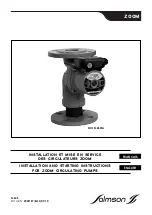
6 720 607 909
Installation instructions
11
Fig. 11 Mounting the heater
3.5
Combustion air requirements
Twin pipe
The GWH-345/450-ESR is designed as a sealed
combustion appliance. It is recommended that the
combustion air be provided by a dedicated 3” pipe to
the outside. If terminating combustion air piping
horizontally, pitch vent down 1/4" per foot towards
termination to prevent rain from entering the appliance.
The combustion air pipe may be constructed of
aluminum flex, PVC or any other rigid or semi rigid
sealed pipe. The combustion air inlet must be located in
such a manner as to provide a minimum 3 foot distance
from the exhaust vent terminator.
The maximum length of the combustion air inlet is 39
feet with one elbow. Subtract 3 feet for each additional
90° elbow and 1.5 feet for each 45° elbow. Maximum
number of elbows permitted is 4 (see Table 6).
Single pipe
Note:
This appliance requires 6200 cubic feet of
available combustion air, or a minimum of 775 square
feet of space with an 8 foot ceiling to operate. If the
large amount of air space, which equates to about half
of most average sized homes, is not available, the
appliance must pull air from outside (see twin pipe
system above).
Although it is permissible to draw combustion air from
inside the structure, it is not the manufacturer’s recom-
mended installation method. Always install a 3 inch
elbow on the combustion air inlet to prevent foreign
objects from falling into the unit (see Fig. 12).
Fig. 12
If a single pipe installation is utilized, follow guidelines
below for providing adequate combustion air for the
water heater as well as any other appliances that may
consume air in the space. Always follow local codes if
they are more stringent.
This Installation Manual specifies the minimum exhaust
vent length and the amount of combustion air required
for this unit. When all requirements are followed, the
unit will operate properly and safely. However, there
may still be a risk of freezing due to negative draft if the
other combustion appliances in the building are not
supplied with sufficient combustion air. A wood stove or
furnace can pull its combustion air from the heater's
vent pipe, allowing the cold incoming air to freeze the
cold water in the heat exchanger. Supplying more
combustion air for all combustion appliances is the
solution. A HVAC specialist should be consulted to
design solutions for providing more combustion air.
Observe the following guidelines:
Installations in structures that have been tightly
constructed (air infiltration rate of 0.40 ACH or less)
must be provided with combustion air per the National
Fuel Gas Code. Consult a HVAC specialist if your air
infiltration rate is questionable.
Warning:
In areas where freezing
temperatures are common the twin pipe
system is recommended. In a single
pipe installation, a negative air condition
may result in cold air being drawn
across the heat exchanger coil causing
it to freeze and burst.
This failure is
not covered under the
manufacturer’s warranty
.
Warning:
When installed in an
environment where corrosive chemicals
or dirty air are present the twin pipe
system is required.











































